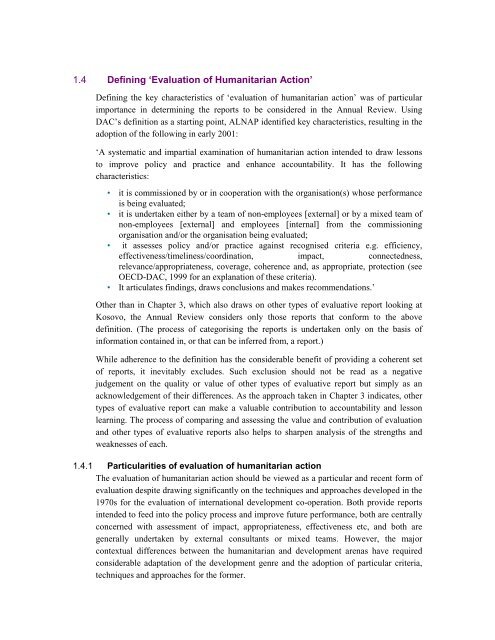Download PDF - ReliefWeb
Download PDF - ReliefWeb
Download PDF - ReliefWeb
Create successful ePaper yourself
Turn your PDF publications into a flip-book with our unique Google optimized e-Paper software.
1.4 Defining ‘Evaluation of Humanitarian Action’<br />
Defining the key characteristics of ‘evaluation of humanitarian action’ was of particular<br />
importance in determining the reports to be considered in the Annual Review. Using<br />
DAC’s definition as a starting point, ALNAP identified key characteristics, resulting in the<br />
adoption of the following in early 2001:<br />
‘A systematic and impartial examination of humanitarian action intended to draw lessons<br />
to improve policy and practice and enhance accountability. It has the following<br />
characteristics:<br />
• it is commissioned by or in cooperation with the organisation(s) whose performance<br />
is being evaluated;<br />
• it is undertaken either by a team of non-employees [external] or by a mixed team of<br />
non-employees [external] and employees [internal] from the commissioning<br />
organisation and/or the organisation being evaluated;<br />
• it assesses policy and/or practice against recognised criteria e.g. efficiency,<br />
effectiveness/timeliness/coordination, impact, connectedness,<br />
relevance/appropriateness, coverage, coherence and, as appropriate, protection (see<br />
OECD-DAC, 1999 for an explanation of these criteria).<br />
• It articulates findings, draws conclusions and makes recommendations.’<br />
Other than in Chapter 3, which also draws on other types of evaluative report looking at<br />
Kosovo, the Annual Review considers only those reports that conform to the above<br />
definition. (The process of categorising the reports is undertaken only on the basis of<br />
information contained in, or that can be inferred from, a report.)<br />
While adherence to the definition has the considerable benefit of providing a coherent set<br />
of reports, it inevitably excludes. Such exclusion should not be read as a negative<br />
judgement on the quality or value of other types of evaluative report but simply as an<br />
acknowledgement of their differences. As the approach taken in Chapter 3 indicates, other<br />
types of evaluative report can make a valuable contribution to accountability and lesson<br />
learning. The process of comparing and assessing the value and contribution of evaluation<br />
and other types of evaluative reports also helps to sharpen analysis of the strengths and<br />
weaknesses of each.<br />
1.4.1 Particularities of evaluation of humanitarian action<br />
The evaluation of humanitarian action should be viewed as a particular and recent form of<br />
evaluation despite drawing significantly on the techniques and approaches developed in the<br />
1970s for the evaluation of international development co-operation. Both provide reports<br />
intended to feed into the policy process and improve future performance, both are centrally<br />
concerned with assessment of impact, appropriateness, effectiveness etc, and both are<br />
generally undertaken by external consultants or mixed teams. However, the major<br />
contextual differences between the humanitarian and development arenas have required<br />
considerable adaptation of the development genre and the adoption of particular criteria,<br />
techniques and approaches for the former.
















![CynefinFramework final [Read-Only]](https://img.yumpu.com/19017304/1/190x135/cynefinframework-final-read-only.jpg?quality=85)